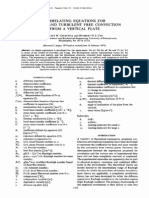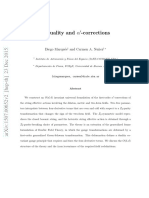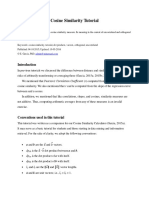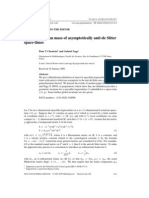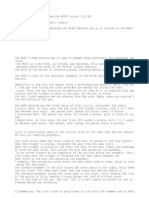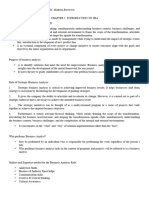A Generalized Gardner Relation: X/X Is The
A Generalized Gardner Relation: X/X Is The
Uploaded by
akreminho89Copyright:
Available Formats
A Generalized Gardner Relation: X/X Is The
A Generalized Gardner Relation: X/X Is The
Uploaded by
akreminho89Original Description:
Original Title
Copyright
Available Formats
Share this document
Did you find this document useful?
Is this content inappropriate?
Copyright:
Available Formats
A Generalized Gardner Relation: X/X Is The
A Generalized Gardner Relation: X/X Is The
Uploaded by
akreminho89Copyright:
Available Formats
A generalized Gardner relation
A generalized Gardner relation
Charles P. Ursenbach
ABSTRACT
Gardner’s relation is extended to include dependence on both shear and
compressional velocity. Data for fitting are generated from work on Gardner-type
relations by Wang (2000). It is found that a single relation of this form can
reasonably represent several lithologies.
INTRODUCTION
Gardner's relation (ρ = Cα1/4, ρ = density, α = compressional velocity) has been
widely used as a means of providing approximate densities or compressional
velocities, when one was available and the other not (Gardner et al., 1974). Other
empirical forms for a density-velocity relation are possible, such as Birch's Law and
Lindseth's relation. One of the advantages of Gardner's form however is in its
application to AVO, as demonstrated by Smith and Gidlow (1987). In traditional
AVO one uses information on P-P reflection coefficients as input to an inversion
process that yields ∆ρ/ρ, ∆α/α, and ∆β/β as output (β = shear velocity, and ∆x/x is the
difference x divided by the average of x across an interface). This procedure is
strongly stabilized by reducing the number of output variables from three to two.
One way to accomplish this for linear inversion is by substituting for the density
contrast with a relation of the form
∆ρ ∆α
= c1 + c2 . (1)
ρ α
Integrating this yields
ln ρ = c1 ln α + c 2 α + c3 (2)
or
ρ = c3 α c1 e c2 α (3)
This is exactly the form of Gardner's relation, with c1 = ¼ and c2 = 0, and the
substitution of Equation (1) is precisely what Smith and Gidlow proposed. Such a
simple manipulation is not possible with other empirical density-velocity relations.
There are a variety of changes one could propose and still retain the essential form
of Gardner's relation. Castagna et al. (1993) for instance proposed a set of lithology
specific relations. Work by Dey and Stewart (1997), Potter and Stewart (1998), and
Potter (1999) has used Blackfoot log data to develop ρ-β relations. More recently,
Wang (2000) has used laboratory data to develop ρ-α and ρ-β relations for six
different lithologies, for both gas- and water-saturation.
CREWES Research Report — Volume 13 (2001) 77
Ursenbach
Dey (2001) noted the possibility of developing an empirical relation involving all
three variables. We reason here that because of the greater flexibility in fitting
permitted by use of an additional variable, this method may have the ability to
represent multiple lithologies with accuracy, using only a single expression.
Individual lithologies have well-defined relations between α and β (see, for instance,
Mavko et al., Section 7.8), so it is hoped that fitting ρ to both α and β will allow the
α-β relations to be incorporated implicitly into a generalized Gardner relation.
One use of such a relation would be to predict shear velocity logs from the more
commonly obtained density and sonic logs. When lithology is know, α-β relations
are generally used to predict β from α. However if lithology is not known, a single
lithology-independent β(ρ,α) relation would be very useful. Another potential
application, given the appropriate functional form, is an analogy to the Smith-Gidlow
AVO method. In this paper we propose a function of the form:
ρ = Cα A β B (4)
which yields the relation
dρ dα dβ
=A +B . (5)
ρ α β
The potential use of Equation (5) in AVO is explored elsewhere in this volume
(Ursenbach and Stewart, 2001).
METHOD & RESULTS
We develop an empirical expression of the form of Equation (4) using Wang’s
empirical lithology-specific expressions as input. Gardner’s relation is intended to
describe water-saturated rocks, so we use the water saturation version of Wang’s
equations. First, for each lithology, we generate a set of densities in a range normal
for that lithology. The ranges actually employed are shown in Table I:
Table I. Ranges of densities values employed for generating input data for each lithology
Lithology Dolomite Limestone Sandstone Shaley Unconsol. Shale
Sandstone Sandstone
Density
Range 2.45-2.85 1.85-2.75 2.10-2.60 2.05-2.55 2.05-2.30 2.30-2.70
(g/cm3)
From these density values we employ Wang’s equations [Equations (6) and (7) from
his paper] to generate values of α and β. These are of the form α = c ρd, which is
simply a rearrangement of Gardner’s relation, and similarly β = c ρd. We then fit the
resulting (ρ,α,β) triples from all lithologies to the expression
78 CREWES Research Report — Volume 13 (2001)
A generalized Gardner relation
ln ρ = ln C + A ln α + B ln β (6)
to obtain A, B, and lnC. For units of g/cm3 and km/s, this yields A = −0.091, B =
0.319, and C = 2.10.
These are not our final suggested results however. A test was carried out to see
how well α and β predicted by Wang’s equations satisfy extant α-β relations (Mavko
et al., 1998, Sec. 7.8). In fact they deviate somewhat, as illustrated for dolomite in
the figure below:
FIG. 1. Values of β/α predicted by Wang’s equations compared to α-β relation from Mavko et
al., Sec. 7.8.
There is generally much less data scatter about a best-fit α-β relation than about a
best-fit ρ-α or ρ-β relation. Thus it seems important to constrain the fitting to satisfy
the α-β relations. To accomplish this we weighted the data by creating additional
points. The first way this was done was as follows. For each (ρ,α,β) in the data set,
we also included (ρ, aβ+b, cα+d), where (a,b,c,d) are appropriate constants obtained
from the α-β relations. After including these points in the fit we obtained A = 0.103,
B = 0.146, and C = 1.83 using 1000 density points for each lithology. The correlation
coefficient had a value of 0.83. The sum of A and B is 0.249, very close to the ¼
exponent of Gardner’s relation. It is reasonable that they are of similar size, but
likely a coincidence that they are so nearly identical. C is also of similar magnitude
CREWES Research Report — Volume 13 (2001) 79
Ursenbach
to the corresponding constant in Gardner’s relation, which is 1.741 (for units of g/cm3
and km/s).
A visual representation of the fit is presented in Figure 2 below. Density is plotted
against shear and compressional velocity in the following way. The horizontal and
vertical axes represent α and β respectively. For each data triple, the density is
plotted at the appropriate location as a short line, whose angle with the horizontal
represents the magnitude of the density. A horizontal line represents the minimum
density in Table I, and a vertical line represents the maximum density. The black
lines represent input triples, and the lighter lines over top represent the density
predicted by Equation (4) after fitting. For each (α,β) pair, the input and output ρ
values cross over at their midpoints. For a very good fit the lighter line eclipses the
black line. The displayed results employed 5 density points for each lithology, so the
fitting results differ slightly from those given above. One observes a few results that
are noticeably less satisfactory than others. These correspond to low densities in the
limestone lithology. In general though, this appears to be a reasonable method for
fitting data from several lithologies
FIG. 2. Comparison of fitted density to input density. The density for a given (VP=α, VS=β) pair
is given by the angle of the line with respect to the horizontal (horizontal = minimum density in
range, vertical = maximum density). The black lines represent the original input densities,
from which α and β were predicted by Wang’s Equations (6) and (7). This data was then fit to
80 CREWES Research Report — Volume 13 (2001)
A generalized Gardner relation
Equation (4), and the values of ρ predicted by the fit of Equation (4) for the same (α, β) pairs
are given by the lighter colored line on top of the black line.
A second method for including extra points was to replace each (ρ,α,β) with
(ρ,α,aα+b) and (ρ,cβ+d,β). Fitting this data yielded A = 0.0799, B = 0.164, and C =
1.87, again using 1000 density points for each lithology. The correlation coefficient
again had a value of 0.83, and plotting the result gave a result similar to that in Figure
2. The sum of A and B is 0.244, again close to ¼.
Comparison with Gardner’s Relation
To test the value of this result we compare it to three other relations. The first is
the original Gardner’s Relation, the second is Gardner’s relation with coefficients
refit to the present data, and the third is a Gardner-type relation depending only on VS
and not on VP. The three expressions therefore are
ρ = 1.741 VP 0.25 (Gardner’s relation) (7)
ρ = Ap VP Bp
(Gardner’s relation refit) (8)
ρ = As VP Bs (Gardner-like VS relation) (9)
A least-squares method is used to determine Ap, Bp, As, and Bs from the logarithmic
version of Equations (8) and (9). The fitting coefficients obtained are Ap = 1.61, Bp
= 0.278, As = 1.97, and Bs = 0.235. For each of Equations (4), (7), (8), and (9), we
then determine an goodness-of-fit function as
Goodness-of-fit = √ [ (1/N) Σ|ρinput − ρoutput| ] (10)
where N is the number of points and Σ indicates a sum over all points. The goodness
values calculated are 0.119 g/cm3 for Equation (4), 0.154 g/cm3 for Equation (7),
0.122 g/cm3 for Equation (8), 0.120 g/cm3 for Equation (9). Thus Equation (4) is
slightly superior to Equations (8) and Equation (9), indicating a strong correlation
between VP and VS.
CONCLUSIONS
Gardner’s relation, ρ = 1.741 α1/4 (for ρ in g/cm3 and α in km/s), is generalized
herein to ρ = C αA βB, where C is similar in size to 1.741 and A + B ≈ ¼. This result
is expected to be reasonably accurate for several water-saturated lithologies.
Limestone appears to be the least well described. This result would be useful both for
predicting shear velocities and for substituting velocity contrasts for density contrasts
in AVO inversion approximations.
CREWES Research Report — Volume 13 (2001) 81
Ursenbach
REFERENCES
Castagna, J.P., Batzle, M.L., and Kan, T.K., 1993. Rock physics – The link between rock properties
and AVO response, in Offset-Dependent Reflectivity – Theory and Practice of AVO Analysis,
J.P. Castagna and M. Backus, eds. Investigations in Geophysics, No. 8, Society of
Exploration Geophysicists, Tulsa, Oklahoma, 135-171.
Dey, A.K., 2001. Private communication.
Dey, A.K., and Stewart, R.R., 1997. Predicting density using VS and Gardner’s relationship, in
CREWES 1997 Research Report, Vol. 9.
Gardner, G.H.F., Gardner, L.W., and Gregory, A.R., 1974. Formation velocity and density – The
diagnostic basics for stratigraphic traps. Geophys., 39, 770-780.
Mavko, G., Mukerji T., and Dvorkin, J., 1998. The Rock Physics Handbook: Tools for Seismic
Analysis in Porous Media. Cambridge University Press, 1998.
Potter, C.C., 1999. Relating density and elastic velocities in clastics: an observation, in CREWES 1999
Research Report, Vol. 11.
Potter, C.C., and Stewart, R.R., 1998. Density predictions using VP and VS sonic logs, in CREWES
1998 Research Report, Vol. 10.
Smith, G.C., and Gidlow, P.M. 1987. Weighted stacking for rock property estimation and detection of
gas. Geophys. Prospecting, 35, 993-1014.
Wang, Z., 2000. Velocity-Density Relationships in Sedimentary Rocks, in Seismic and acoustic
velocities in reservoir rocks, Vol. 3, Recent developments. Soc. Expl. Geophys., Geophysics
Reprint Series.
Ursenbach, C.P., and Stewart, R.R., 2001. Testing some new AVO inversion techniques, in CREWES
2001 Research Report, Vol. 13.
82 CREWES Research Report — Volume 13 (2001)
You might also like
- 20pip Strategy 1Document43 pages20pip Strategy 1Qazi Abdul Basit100% (3)
- Tamagotchi Demon Slayer English ManualDocument3 pagesTamagotchi Demon Slayer English Manualduesen100% (2)
- Correlating Equations For Laminar and Turbulent Free ConveDocument7 pagesCorrelating Equations For Laminar and Turbulent Free Convearman_1287No ratings yet
- Elastic Inversion For Lamé Parameters: David Gray, Veritas DGC, IncDocument4 pagesElastic Inversion For Lamé Parameters: David Gray, Veritas DGC, IncMoch SyaifudinNo ratings yet
- Predicting Density Using V and Gardner's Relationship: Ayon K. Dey and Robert R. StewartDocument9 pagesPredicting Density Using V and Gardner's Relationship: Ayon K. Dey and Robert R. StewartPeng TerNo ratings yet
- An Inequality Concerning The Production of Vorticity: in Isotropic TurbulenceDocument8 pagesAn Inequality Concerning The Production of Vorticity: in Isotropic TurbulencequioxxNo ratings yet
- DensitypredictionsDocument11 pagesDensitypredictionsZeinab.elbarbaryNo ratings yet
- The Sandpile Group of A Trinity and A Canonical Definition For The Planar Bernardi ActionDocument34 pagesThe Sandpile Group of A Trinity and A Canonical Definition For The Planar Bernardi ActionPavloNo ratings yet
- Effect of Shear Friction On Solid Flow Through An Orifice (1991)Document5 pagesEffect of Shear Friction On Solid Flow Through An Orifice (1991)池定憲No ratings yet
- Roughness Coefficient in Mountain Rivers: Alfonso Ugarte SotoDocument8 pagesRoughness Coefficient in Mountain Rivers: Alfonso Ugarte SotoDavid RochaNo ratings yet
- Papers Fall VelocityDocument7 pagesPapers Fall VelocityAnonymous K02EhzNo ratings yet
- 1998-Chen-A Numerical Method For Two-Phase Flows With An InterfaceDocument9 pages1998-Chen-A Numerical Method For Two-Phase Flows With An Interfacemohammad belalNo ratings yet
- 1 s2.0 S0022247X07011547 Main PDFDocument13 pages1 s2.0 S0022247X07011547 Main PDFSaulQuispeTaipeNo ratings yet
- Kurt Haller Department of Physics, University of Connecticut, Storrs, CT 06269Document8 pagesKurt Haller Department of Physics, University of Connecticut, Storrs, CT 06269Bayer MitrovicNo ratings yet
- Method of Characteristics and Velocity of Sound Reacting: For GasesDocument2 pagesMethod of Characteristics and Velocity of Sound Reacting: For GasesVgokulGokulNo ratings yet
- First Report 1Document10 pagesFirst Report 1Israel Abraham Barragan VidalNo ratings yet
- Analisis - Angulo de Dominio de La Amplitud - AVODocument18 pagesAnalisis - Angulo de Dominio de La Amplitud - AVOfiebritosNo ratings yet
- GIIP Comparison Using Different Saturation Height Methods: Matthew MeyerDocument14 pagesGIIP Comparison Using Different Saturation Height Methods: Matthew Meyerc_b_umashankarNo ratings yet
- Drag LawsDocument10 pagesDrag LawsRelining MineralsNo ratings yet
- 3Document7 pages3amithbmNo ratings yet
- Simultaneous Inversion of Pre-Stack Seismic Data: Daniel P. Hampson, Brian H. Russell and Brad BankheadDocument5 pagesSimultaneous Inversion of Pre-Stack Seismic Data: Daniel P. Hampson, Brian H. Russell and Brad BankheadAnastasia Dwiayu HiasintaNo ratings yet
- Oliveira Santos Carama AIProcDocument5 pagesOliveira Santos Carama AIProcLarissa FigueiredoNo ratings yet
- Distribution Eddy Viscosity Length: Mixing inDocument6 pagesDistribution Eddy Viscosity Length: Mixing inGustavo Gabriel JimenezNo ratings yet
- Coordination Number in Liquid ArgonDocument10 pagesCoordination Number in Liquid Argon09187135911No ratings yet
- Application of Ergun Equation To Computation of Criticalication oDocument21 pagesApplication of Ergun Equation To Computation of Criticalication oAbdallah abdellaouiNo ratings yet
- finsler (1)Document38 pagesfinsler (1)inimgharNo ratings yet
- Bravais Pearson and Spearman Correlation Coefficients 2002Document4 pagesBravais Pearson and Spearman Correlation Coefficients 2002fp ceNo ratings yet
- Funcionales de La DensidadDocument7 pagesFuncionales de La DensidadI. RodriguezNo ratings yet
- Evaporationwater v5 JensDocument14 pagesEvaporationwater v5 Jensroushan05251990No ratings yet
- E, Figge: A N Empirical Equation Relating Fatigue Limit A N D Mean StressDocument31 pagesE, Figge: A N Empirical Equation Relating Fatigue Limit A N D Mean StressYusvari Harza IrawanNo ratings yet
- Shielding CalculationDocument17 pagesShielding Calculationrammar147No ratings yet
- Lesson 9-Relations & Their Properties: Definition 1Document9 pagesLesson 9-Relations & Their Properties: Definition 1Udeshika WanninayakeNo ratings yet
- T-duality and α -correctionsDocument36 pagesT-duality and α -correctionsMatias VolijNo ratings yet
- Drag Coefficient-ReynoldsDocument5 pagesDrag Coefficient-ReynoldszuizelamnhaNo ratings yet
- Sand Liquefaction by Hypoplastic ModelDocument7 pagesSand Liquefaction by Hypoplastic ModelAnna SuuNo ratings yet
- A Review of Non Iterative Friction Factor Correlations For The Calculation of Pressure Drop in PipesDocument8 pagesA Review of Non Iterative Friction Factor Correlations For The Calculation of Pressure Drop in PipesJoão Rubens MartinsNo ratings yet
- 147.213.145.2 VC Articles 2015 63 InProgress Assefa 1Document11 pages147.213.145.2 VC Articles 2015 63 InProgress Assefa 1abdullaalakourNo ratings yet
- 7873-PDF File-25873-1-10-20181008Document15 pages7873-PDF File-25873-1-10-20181008cyclicheNo ratings yet
- A Consistent Rule For Selecting Roots in Cubic Equations of State PDFDocument3 pagesA Consistent Rule For Selecting Roots in Cubic Equations of State PDFToño CamargoNo ratings yet
- LauritzenDocument45 pagesLauritzenSteffen VentzNo ratings yet
- Van GenuchtenDocument21 pagesVan GenuchtenrshaghayanNo ratings yet
- A Comparison of Hydrocarbon Indicators Derived From AVO AnalysisDocument9 pagesA Comparison of Hydrocarbon Indicators Derived From AVO AnalysisbiriNo ratings yet
- 4Document4 pages4amithbmNo ratings yet
- Stokoe and Stokoe (2001) Plenary PaperDocument10 pagesStokoe and Stokoe (2001) Plenary Paperjames_frankNo ratings yet
- An Examination of Flow MechanismsDocument20 pagesAn Examination of Flow Mechanismsxusheng wangNo ratings yet
- Cosine Similarity TutorialDocument7 pagesCosine Similarity TutorialEduardsh EduardNo ratings yet
- level setDocument45 pageslevel setAnh Nguyễn Thị VânNo ratings yet
- R Zero-Offset P-P Reflection Coefficient, R Zero-Offset S-Wave Reflection CoefficientDocument14 pagesR Zero-Offset P-P Reflection Coefficient, R Zero-Offset S-Wave Reflection CoefficientYannick Ange Karmel THIERONo ratings yet
- A Holistic Approach To Particle Drag Prediction: Teresa L. ThompsonDocument10 pagesA Holistic Approach To Particle Drag Prediction: Teresa L. Thompsonmuhammad aashanNo ratings yet
- Bayesian Networks - Exercises: 1 Independence and Conditional IndependenceDocument20 pagesBayesian Networks - Exercises: 1 Independence and Conditional IndependenceCandy AngelNo ratings yet
- Piotr T Chrusciel and Gabriel Nagy - The Hamiltonian Mass of Asymptotically Anti-De Sitter Space-TimesDocument8 pagesPiotr T Chrusciel and Gabriel Nagy - The Hamiltonian Mass of Asymptotically Anti-De Sitter Space-TimesGijke3No ratings yet
- 33 2005 Article BF01594906Document8 pages33 2005 Article BF01594906eqNo ratings yet
- (A) Analysis and Estimation of The Coefficient of Consolidation - Raju Et Al., 1995Document7 pages(A) Analysis and Estimation of The Coefficient of Consolidation - Raju Et Al., 1995JociellNo ratings yet
- Standard Error of RDocument20 pagesStandard Error of Raukie999No ratings yet
- A Comparative Study of Friction Factor Correlations For High Concentrate Slurry PDFDocument11 pagesA Comparative Study of Friction Factor Correlations For High Concentrate Slurry PDFVighnesh PrasadNo ratings yet
- Broyden's Method For Self-Consistent Field Convergence AccelerationDocument6 pagesBroyden's Method For Self-Consistent Field Convergence Accelerationhoehoe1234No ratings yet
- Edwards & Parry 1993 Polynomial Regression 1Document37 pagesEdwards & Parry 1993 Polynomial Regression 14snkm2b8yjNo ratings yet
- An Empirical Failure Criterion For Rocks and Jointed Rock MassesDocument19 pagesAn Empirical Failure Criterion For Rocks and Jointed Rock MassesYiwei LiNo ratings yet
- I-Ray: The Scherrer For Particle SizeDocument5 pagesI-Ray: The Scherrer For Particle SizeNabeel Ali Al-Miz'elNo ratings yet
- Weyl Group Multiple Dirichlet Series: Type A Combinatorial TheoryFrom EverandWeyl Group Multiple Dirichlet Series: Type A Combinatorial TheoryNo ratings yet
- Simple Algebras, Base Change, and the Advanced Theory of the Trace FormulaFrom EverandSimple Algebras, Base Change, and the Advanced Theory of the Trace FormulaNo ratings yet
- CAS Media Release Wydad Esperance Sportive CAFDocument1 pageCAS Media Release Wydad Esperance Sportive CAFakreminho89No ratings yet
- A Natural Oil Seep in The Floodplain of The Amga River (Siberian Platform)Document5 pagesA Natural Oil Seep in The Floodplain of The Amga River (Siberian Platform)akreminho89No ratings yet
- The Lower and Middle Jurassic of The Western Mediterranean Tethys (Morocco, Algeria, and Tunisia)Document5 pagesThe Lower and Middle Jurassic of The Western Mediterranean Tethys (Morocco, Algeria, and Tunisia)akreminho89No ratings yet
- Janjuhah 2017Document14 pagesJanjuhah 2017akreminho89No ratings yet
- Abundance: 24000 Ion 191.00 (190.70 To 191.70) : RE-OS-SAT-04214.D/data - MsDocument1 pageAbundance: 24000 Ion 191.00 (190.70 To 191.70) : RE-OS-SAT-04214.D/data - Msakreminho89No ratings yet
- Seismic-Stratigraphy of Shuswap Lake, British Columbia, CanadaDocument21 pagesSeismic-Stratigraphy of Shuswap Lake, British Columbia, Canadaakreminho89No ratings yet
- Pyrolysis Analysis of Crude Oils and Their Fractions: Ozgen Karacan and Mustafa Versan KokDocument7 pagesPyrolysis Analysis of Crude Oils and Their Fractions: Ozgen Karacan and Mustafa Versan Kokakreminho89No ratings yet
- Bab Gec 3101 Midterm Module 1Document46 pagesBab Gec 3101 Midterm Module 1Marc Oliver NabablitNo ratings yet
- 240c ClassDocument3 pages240c ClassDan SloNo ratings yet
- Dames and Moore - 1981-Geologic Reconnaissance Survey Prima DeshechaDocument20 pagesDames and Moore - 1981-Geologic Reconnaissance Survey Prima DeshechaBrian McDanielNo ratings yet
- RKR Spring 2010 Recipe Book: Whipped CreamDocument38 pagesRKR Spring 2010 Recipe Book: Whipped Creamlookitschex100% (1)
- Motorcycle Gearing CalculatorDocument3 pagesMotorcycle Gearing CalculatorH3liax100% (3)
- Design and Development of Tube-Launched Unmanned Aerial VehicleDocument5 pagesDesign and Development of Tube-Launched Unmanned Aerial VehiclebeshirNo ratings yet
- Robotics SeminarDocument14 pagesRobotics Seminardmharithra2212100% (1)
- According To Regulation (EC) No 1907/2006, Annex II: Safety Data Sheet AlkbuildDocument8 pagesAccording To Regulation (EC) No 1907/2006, Annex II: Safety Data Sheet AlkbuildRadwan AL TrougNo ratings yet
- Power Losses in Wound Components PDFDocument12 pagesPower Losses in Wound Components PDFPedNo ratings yet
- Statistics and Probability - STA301 Power Point Slides Lecture 01Document73 pagesStatistics and Probability - STA301 Power Point Slides Lecture 01Rabia AftabNo ratings yet
- Temazepam (Restoril)Document1 pageTemazepam (Restoril)E100% (2)
- Land Rover Defender Sales Brochure PDFDocument1 pageLand Rover Defender Sales Brochure PDFJan Svein HammerNo ratings yet
- Tugas Nisrina Zalva 3a Pertemuan 13Document3 pagesTugas Nisrina Zalva 3a Pertemuan 13Nisrina ZalvaNo ratings yet
- Instant Download Pharmacogenomics and Personalized Medicine Methods in Pharmacology and Toxicology Methods in Pharmacology and Toxicology 1st Edition Nadine Cohen PDF All ChaptersDocument50 pagesInstant Download Pharmacogenomics and Personalized Medicine Methods in Pharmacology and Toxicology Methods in Pharmacology and Toxicology 1st Edition Nadine Cohen PDF All Chaptershijarrazan1e100% (13)
- Analysis of Four Wave Mixing Final Year ProjectDocument1 pageAnalysis of Four Wave Mixing Final Year ProjectNauman HameedNo ratings yet
- Lease AGREEMENT GummadiDocument5 pagesLease AGREEMENT GummadiSwaroopNo ratings yet
- MaxiBAS BT506 User ManualDocument46 pagesMaxiBAS BT506 User ManualGeoDude51No ratings yet
- Electromagnetic Signals: Engr. Mark Jefferson A. Arellano, Ect, VCP, RtaDocument52 pagesElectromagnetic Signals: Engr. Mark Jefferson A. Arellano, Ect, VCP, RtaMark ArrelanoNo ratings yet
- VSAT NetworksDocument28 pagesVSAT NetworksAhmad Salam AbdoulrasoolNo ratings yet
- LTE CommandsDocument1,200 pagesLTE CommandsMostafa Mohamed Elagory84% (25)
- SpirotechDocument2 pagesSpirotechBimalesh MishraNo ratings yet
- Coal Trans Japan September 2016Document12 pagesCoal Trans Japan September 2016Irfan Nasution MhdNo ratings yet
- Acknowledgements: Dr. Hla Hla MyintDocument2 pagesAcknowledgements: Dr. Hla Hla Myintလင္း ထိုက္No ratings yet
- Cultural Hegemony: A Gramscian Perspective On Counterculture - Gaelle MazraanyDocument5 pagesCultural Hegemony: A Gramscian Perspective On Counterculture - Gaelle MazraanyGaelle Mazraani100% (1)
- Sba Midterm ReviewerDocument11 pagesSba Midterm ReviewerErica FlorentinoNo ratings yet
- Guyabano Is Natural Cancer CureDocument16 pagesGuyabano Is Natural Cancer CureCyril CavitaNo ratings yet
- Vajrasekhara Sutra Vajradhatu Great Bodhimanda Mahavairochana Tathagata Personal Enjoyment Body Inner Realization Wisdom Followers ofDocument7 pagesVajrasekhara Sutra Vajradhatu Great Bodhimanda Mahavairochana Tathagata Personal Enjoyment Body Inner Realization Wisdom Followers ofWilliam D. Jackson IIINo ratings yet
- Final DemoDocument47 pagesFinal DemoSean Paul Jimenez100% (1)


